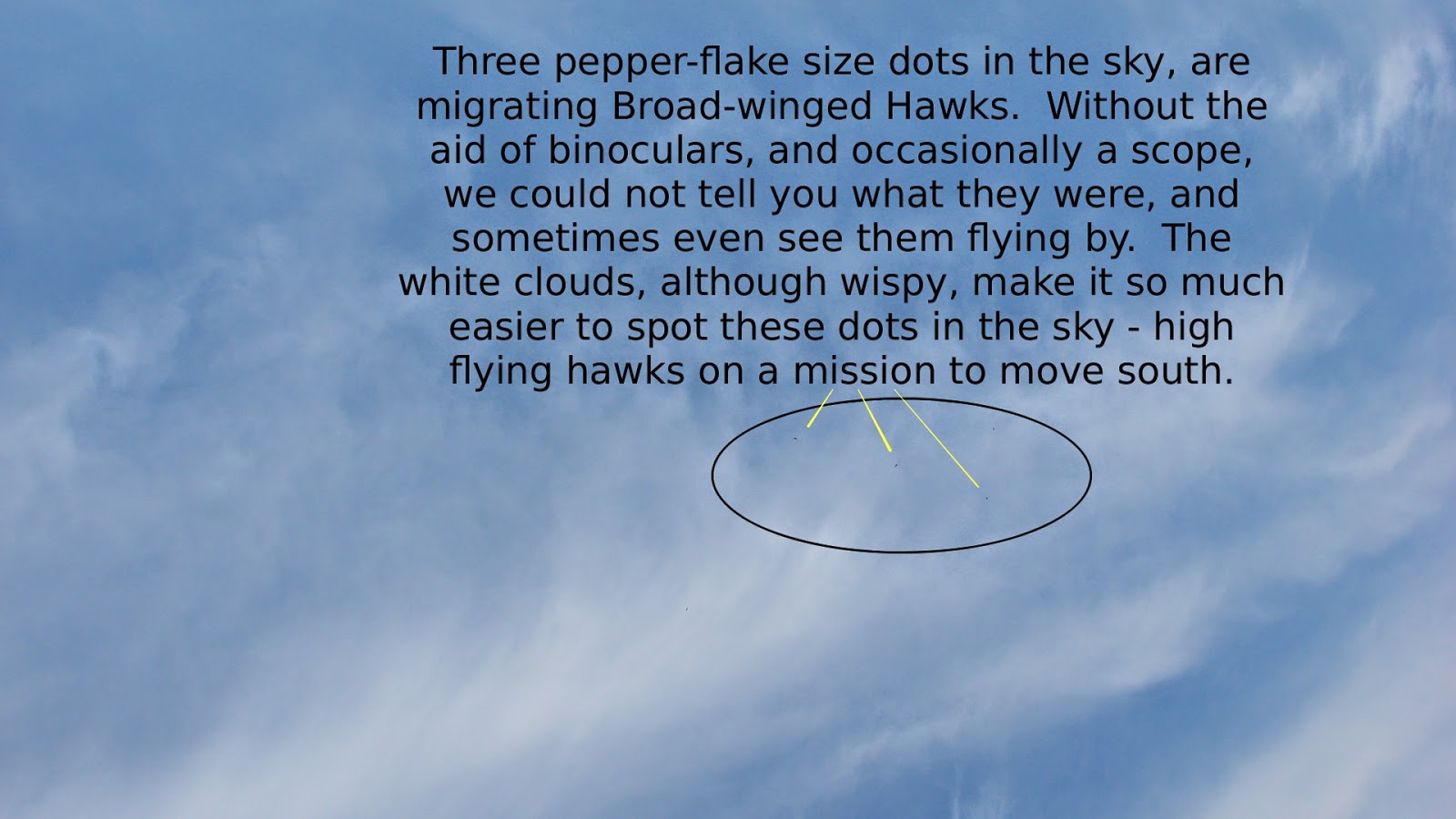The hawks we see are often high enough that they appear more as specks than as actual bird shapes. Lots of bright clouds whether, billowing or wispy, help us do 2 things. 1.We can see the birds more easily against clouds than against blue sky when they are high. And, 2. the clouds' shapes and sizes, help us locate those same birds to other watchers, so they may "get on" the birds, helping us to verify our counts. Below is a picture that indicates the location of 3 tiny BW's in a large sky. But if you zoom into that same picture there are actually 5 hawks there.
Extra eyes help us not to miss the one flying below the others, or trailing out behind -or the ones we missed because they were flying ahead of the group. Once we spot hawks, someone usually stays on the one or more they have found, perhaps to count more in the immediate area. But at least one watcher, should scan the sky out in front of these birds and someone chase behind to see if there are more birds coming into that "kettle" or group. It isn't always helpful to count those behind, but just note as FYI that more are flying in to meet the others. Otherwise counts can be confusing. But it's important to count those that have "gone on." (are out there ahead of the group, and perhaps nearing escaping visibility since they obviously have passed through without our seeing them.) Their numbers might otherwise be lost. Sometimes a person scanning back might count but reserve the total, to double ck the count of birds that enter the general initial count area. Comparing those numbers can discover that we are missing birds in the periphery.
Click on the picture and hopefully you will recognize how important a pair of binoculars are. We usually employ 8 x 32, or 10 x 40 binocs. This refers to the magnification properties of the lenses. Coated lenses cut the glare, and often help during temp changes. Short or close focus capabilities help us to zoom quickly onto butterflies and warblers that land nearby. Yet comfort while looking through them for extended periods is important too. But come with whatever you have. Many have seen their first special raptor through pocket sized binocs. There are days we never see a single hawk without the aid of a pair of binoculars, and on other days, they fly low all day and can be seen by the naked eye. But not often.
Count the hawks you see. Did you see 4?
#4 is smaller because it is also higher. Proper adjustment of your binoculars to a distance beyond what you are immediately seeing may reveal more distant birds. At the hawk watch, we may instruct you to focus on an object way out on the horizon, and advise you not to move the focus wheel as you peer into the blue. Adjusting for closer clouds, for example, may cause you to miss the birds flying at the height of that tiny bird above the others.
Below, is another great example. Can you identify 2 raptors?
Can you see the tiny speck to the left of the Bald Eagle? From this picture without zooming, it is impossible to know what the other bird is. It looks like a smaller bird. It is however, a second Bald Eagle. This gives real perspective on what we might be seeing against blue skies. The large Bald Eagle is not so difficult to see, but the smaller one, might actually have been missed against blue skies. Clouds here, would have helped.
Note the wide flat wingspan of the Eagle. It's "wing to body" ratio and the flatness of the wings, make it resemble an airplane as it approaches from a distance. I often say that it looks like a flying board. That flatness helps us ID them from far away. In fact, even when I zoom in on this picture, I would not know what the upper bird was, except it looks like a board with rounded ends. A classic Bald Eagle shape. And against the sky in the distance...I can't see it's white head and tail. Just that long flat cigar shape that is black and solid. Eagles seldom move their wings, except when facing winds or accelerating to heights more rapidly than rising air currents would take them, without the wing power. If I couldn't tell by the wing shape, I certainly could by the fact they almost never flap those wings. These two birds are probably a mated pair.




No comments:
Post a Comment